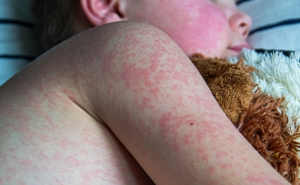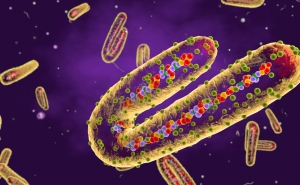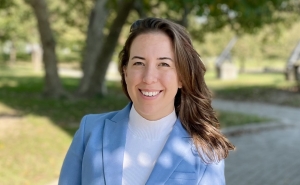The Omicron Variant of COVID-19: A Q&A With Virologist Andrew Pekosz
On paper, omicron looks concerning. How it plays out in the real world has yet to be seen.

Interview by Josh Sharfstein
In this Q&A adapted from the November 30 episode of Public Health On Call, Josh Sharfstein, MD, talks with Andrew Pekosz, PhD, a professor in Molecular Microbiology and Immunology, about omicron, a new COVID-19 variant of concern.
How did omicron come to the world’s attention?
Early last week, some sequences of a variant that came to be known as the omicron variant were passed around and available on some national databases. And they were very concerning on a couple of levels.
There was a large number of mutations in this variant—many more than we would expect from the normal evolution of this virus. Importantly, many mutations occurred in the spike protein—the protein the virus uses to bind to and enter cells—which is the target of the vaccine.Those mutations look like they might allow the virus to escape from vaccine-induced immunity to some degree, allow the virus to bind more tightly to cells, and allow the virus to enter cells faster. On paper, this sequence of the virus looked very concerning.
On [November 25], South African public health officials realized that one of the tests they were using to identify COVID-19 cases could be used as a surrogate for identifying people infected with omicron. That then indicated that there was a large surge of COVID-19 cases being driven by omicron in South Africa. That was the final piece of the puzzle that allowed the South African public health officials to make the announcement that there’s a variant of concern circulating. Of course, that got the attention of everyone in the world who started to monitor for it.
And the World Health Organization jumped in as well?
Absolutely. They’re the ones making the best distinctions about how to gauge a variant of concern with SARS-CoV-2. They immediately saw that data and, relatively quickly, moved this from a relatively unknown variant to a variant of concern (the highest categorization of SARS-CoV-2 viruses).
It sounds like the mutations alone really caused some concern and then there’s some data from the real world showing that the variant can spread.
That’s a good summary of where we are right now.
I’ll point out that we’ve had [other] variants emerge that are concerning. When the beta and gamma variants initially emerged, we thought, this is something we should be worried about. None of those ended up spreading globally in the way we were afraid of—which, of course, is a good thing.
But then we’ve also had variants like alpha and delta, which spread globally with amazing speed. What we want to figure out is: Does omicron fall into the first category or that second category or, perhaps, someplace in between?
How will we figure this out?
Everything comes down to good testing, sequencing, and contact tracing.
What we want to know is: Is this virus spreading? Is it spreading in a way that might suggest that it’s driving the total case numbers in a particular country? And because we’ve seen this variant now appear in a lot of other countries due to travel, we want to start looking for community spread in those other countries, which would be another sign that this is a particularly transmissible virus and raise concerns about it.
A big question is how much protection current vaccines are against this new variant. How do we answer this question?
My lab, for instance, is on the lookout to get virus isolates into the laboratory to do those kinds of tests, to directly get data [on] how sensitive or resistant the variant is to antibodies induced by either vaccines or infection.
Several laboratories, and vaccine manufacturers, are using other methods based solely on the available sequence to generate what’s called pseudo-viruses that can allow them to do the same types of experiments.
Getting data on how well vaccine-induced immunity recognizes omicron is important because that’s going to tell us how susceptible a population is to this particular variant.
Take me into the lab for a second. If you had those isolates right now, what are the tests you’d be doing to answer that question?
We would be doing what’s called a neutralization assay. In that assay, we take a known amount of virus and mix it with serum from individuals who are vaccinated or infected, and then ask, “Does that serum stop the virus from infecting cells?”
It takes about 48 hours to get a readout on a type of antibody called the neutralizing antibody, which a lot of studies have suggested are a really good correlative of protection from infection of SARS-CoV-2.
Another question is whether the variant might cause more severe disease. What do we know about that?
Very little right now. There seems to be a number of people who have been infected with omicron who have been vaccinated or previously infected. The initial reports aren’t of any hospitalizations, but case numbers are very low right now, and that may be just a portion of the population that’s being looked at.
We don’t know anything about disease severity in any substantive way. That’s something else that will come out as we see transmission occurring. We’ll be able to monitor for disease severity and make some assessments of how severe infection with omicron is.
Public Health On Call
This Q&A adapted from the November 30 episode of Public Health On Call Podcast.
So, there’s a lot of data coming both from labs and surveillance in the world. How long before we have a much more detailed picture of the risk posed by omicron?
I think [in terms of] studies of spread in the community, we’ll probably know within a week or two weeks how efficiently this virus is spreading.
It will probably be another two to three weeks before we start to see some data about how well vaccine-immune responses cross-react to omicron. Soon after that, there will be an avalanche of data, but the critical thing is what will happen with omicron in the intervening time. Can the public health interventions—testing, sequencing, and contact tracing—limit the spread of this virus before we really can put together a firm plan for how to counteract it based on its potential risk?
While we’re in this period of concerned uncertainty, what are reasonable steps for governments and people to take? Let’s start with governments and travel restrictions. How do you think about those?
On paper, everyone thinks travel restrictions should work well. In reality, they don’t really work as well as people think they do. There are consequences of travel restrictions in terms of people not wanting to get testing or people not talking about their exposure history.
At best, travel restrictions are one part of a larger, comprehensive strategy that includes more testing, contact tracing, sequencing of viruses, and understanding people’s travel history so you can target testing and sequencing to individuals who might be at an increased risk of infection with omicron.
By themselves, travel restrictions are less than useful, but one can see how in a strategy that includes lots of other things, they are at least one component that could slow the spread of this virus.
Do you think omicron has already spread around the world?
The data right now are showing it’s present in a large and growing number of countries. We don’t have any data yet about community spread in those countries, and that will be critical: Have countries been able to stop it in terms of the travelers coming to those countries? Or have those travelers [already] passed it on to individuals in the community? That will be the critical thing to address right now.
We have to give credit to the scientists and public health officials in South Africa. They bravely came out early to talk about this, and they’re suffering some of the consequences of travel restrictions and some other things. It’s because they came out early with this data that we are probably going to be much more prepared to limit omicron’s public health threat.
Maybe there should be some appreciation and compensation for the harms that some of these countries have experienced.
Absolutely. We’re starting to see issues now where dozens of countries have omicron and travel cases, but they haven’t progressed to any travel restrictions on those countries. It’s the equitable use of these things that isn’t talked about enough.
One global topic that’s come under a lot of scrutiny is the failure of the world to provide vaccines for countries like those that are affected by omicron. Could that have made a difference—if the world had been more aggressive in vaccinating equitably?
Viruses mutate all the time, but viruses aren’t smart. They don’t know where to mutate their genomes to make them more transmissible. It’s just a random event, and because it’s a random event, if you limit the number of cases—if you limit virus replication—you’ll limit the chance that an advantageous mutation accumulates in a virus.
The faster we get vaccines globally, the better off we’ll be. This is just another example of how we have focused on the U.S. vaccination campaign so strongly, almost perhaps at the expense of thinking about this as a global pandemic, that variants can emerge anywhere and because of the ease of travel, [they] can be a threat to the U.S. irrespective of where they emerge. We have to think about this more as a global pandemic and get effective use of vaccines in these countries that have such low access to them right now.
What about for individuals who are reading the news and are getting anxious? What do you tell them? What can people do to protect themselves?
Be proactive. The best thing you can do right now is to get a booster if you haven’t gotten one yet, or get your initial vaccination if you haven’t gotten that yet.
This virus won’t be completely resistant to vaccine-induced immunity because there are lots of regions of the virus that resemble the vaccine strain, so vaccination is still the best way to build population immunity. We know from viruses like influenza, for instance, that even when the vaccine isn’t a perfect match for the circulating virus, the vaccine does provide protection against severe disease, hospitalization, and death. So, go get your vaccinations right now because that’s the one thing the population can do to deal with the potential spread of omicron.
The worst-case scenario is that we have a pretty severe, highly transmissible virus that does reduce the protection from vaccines. At that point, do you think we would potentially need a different kind of booster shot—one designed around the new variant?
That’s something vaccine manufacturers have come to realize. Omicron is different enough to the vaccine that it probably crosses that line to needing some sort of omicron-specific vaccination.
Previous variants that emerged differed at one or two amino acid changes, and when vaccine manufacturers tested variant-specific vaccines against the original vaccines, they didn’t really see a benefit for vaccinating with variant-specific vaccines. Omicron has enough mutations that this needs to be readdressed quickly so that we can bring that on board as a stronger, more effective vaccine if the worst-case scenario does unfold.
Bottom line: There’s reason for concern but we have a whole bunch of scientific tools on our side to protect ourselves. We should take precautions, both at a policy level and as individuals, but we shouldn’t overreact and we should see the big picture of vaccinating the world.
Absolutely. This is not February 2020. We have tools in place, we have immunity in a significant part of the population. This is a concern, but we’re in a much better place to deal with this and mitigate the extreme effects of this variant than we were at the beginning of the pandemic.





